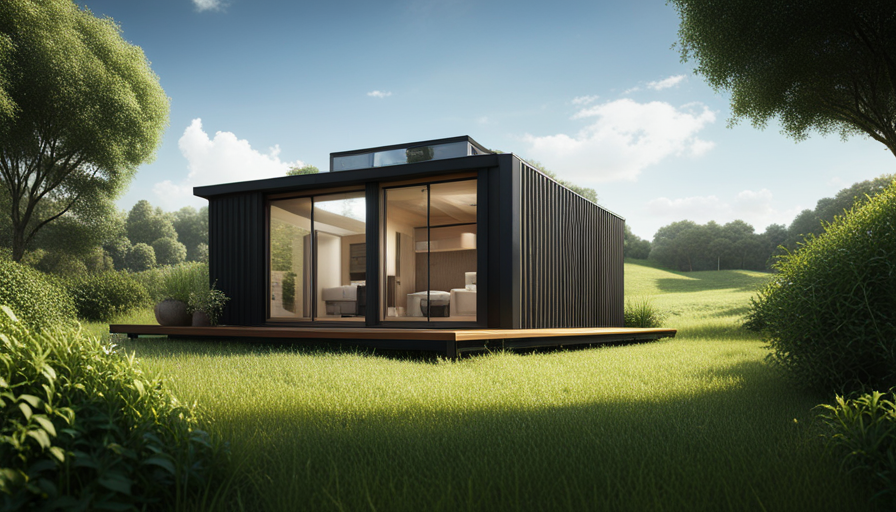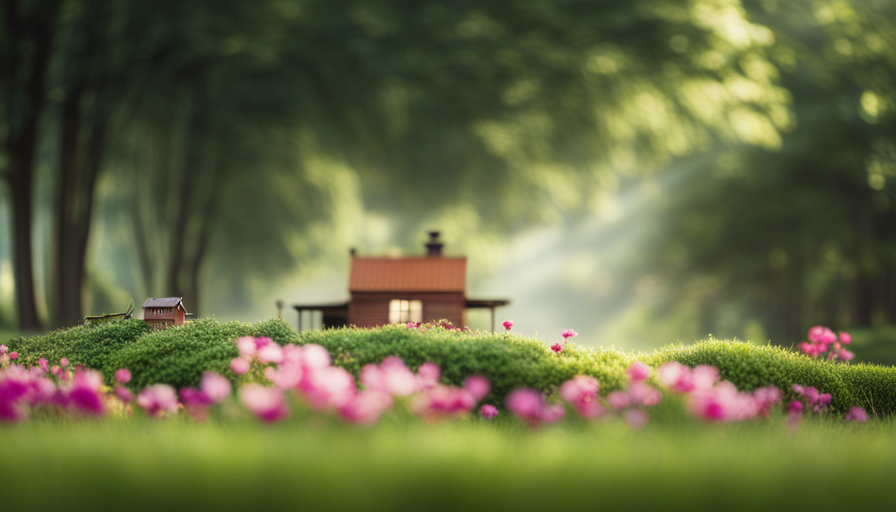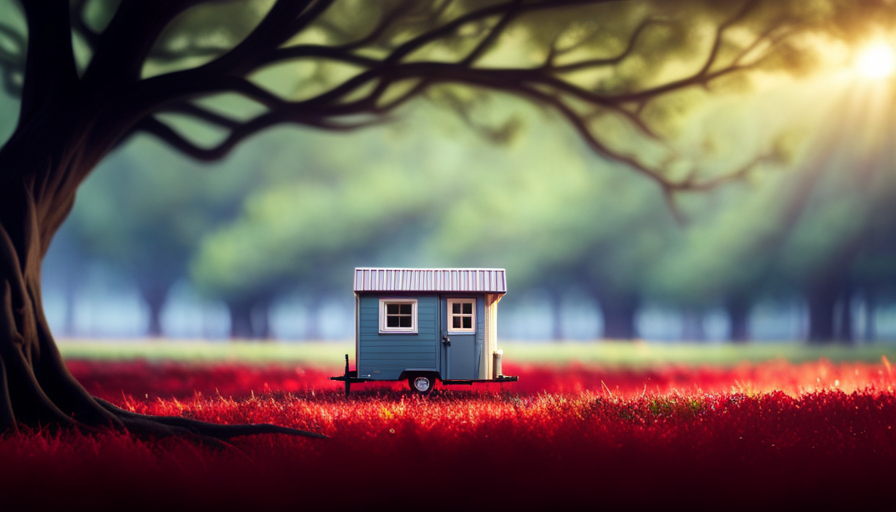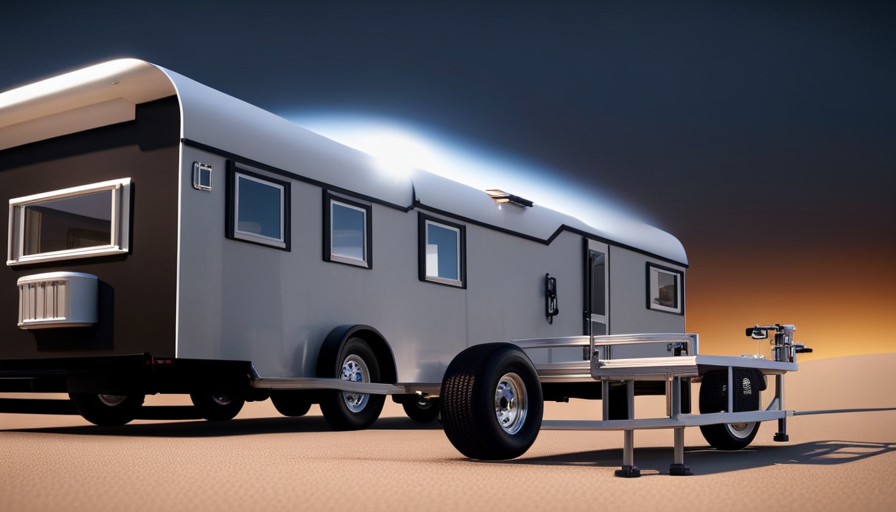Congratulations on choosing to join the tiny house movement and embracing a minimalist lifestyle to reduce your environmental footprint! But before you dive into life in your cozy tiny home, it’s essential to consider the important aspect of water usage.
Yes, even in a tiny house, you’ll need water for cooking, cleaning, and, of course, staying hydrated. But how big of a water tank do you really need? Don’t worry, I’ve got you covered.
In this article, we’ll dive into the depths of water tank sizing for tiny houses, exploring everything from assessing your water usage needs to evaluating the cost and maintenance of water tanks. We’ll calculate your daily water consumption, consider the available water sources, and even discuss backup water solutions.
So grab a cup of your favorite beverage (water, perhaps?), and let’s embark on this watery adventure together. Trust me, by the end of this article, you’ll be a water tank expert, ready to make an informed decision for your tiny house.
Let’s get started!
Key Takeaways
- Assess water usage needs and consider the number of occupants and daily water usage when determining the size of the water tank.
- Consider the available space and design of the tiny house when choosing the size and shape of the water tank, and plan the tank’s location for space optimization and functionality.
- Take into account the available water sources, such as nearby rivers, lakes, or wells, and consider water scarcity and rainwater harvesting options.
- Consider the pros and cons of different types of water tanks, such as plastic, concrete, and stainless steel, and the advantages and disadvantages of above ground and underground tanks.
Assess Your Water Usage Needs
So, how much water do you really need in your tiny house? Assessing your water usage needs is crucial in determining the size of the water tank you’ll need.
By implementing water conservation techniques and utilizing rainwater harvesting systems, you can minimize your water consumption and reduce your reliance on external water sources. Water conservation techniques involve adopting habits that conserve water, such as taking shorter showers, fixing leaky faucets, and using low-flow fixtures. These simple changes can significantly reduce your overall water usage.
Additionally, rainwater harvesting systems allow you to collect and store rainwater for various household needs, including washing dishes, doing laundry, and flushing toilets. This can further reduce your dependence on municipal water supply.
When considering the size of your tiny house, it’s essential to factor in the number of occupants and their daily water usage requirements. Smaller houses with fewer occupants will naturally require a smaller water tank. However, it’s always a good idea to err on the side of caution and choose a slightly larger tank to ensure you have an adequate supply during times of increased water usage, such as when hosting guests.
Assessing your water usage needs is crucial in determining the size of the water tank for your tiny house. By implementing water conservation techniques and utilizing rainwater harvesting systems, you can minimize your water consumption.
When considering the size of your tiny house, it’s important to factor in the number of occupants and their daily water usage requirements.
Transitioning into the next section, let’s now consider the size of your tiny house and how it affects your water tank requirements.
Consider the Size of Your Tiny House
When envisioning the perfect abode, picture the dimensions of your cozy dwelling. This is crucial when considering the size of the water tank for your tiny house. The design of your tiny house will determine the available space for a water tank and its placement.
It is important to carefully plan where the water tank will be located to optimize space and functionality. Tiny house design often prioritizes maximizing every square inch of space. Therefore, it is essential to choose a water tank that fits seamlessly into your tiny house layout. Consider the available vertical and horizontal space when selecting the size and shape of the tank. For example, a tall and narrow tank may be ideal for a tiny house with limited floor space.
Water tank placement is another key factor to consider. Some tiny houses have designated compartments or hidden storage areas where the water tank can be installed. Others may have external compartments or even underfloor storage options. Carefully assess the available space and choose a location that allows for easy access and maintenance of the water tank.
In the subsequent section about determining the available water sources, we will explore how to ensure a reliable supply of water for your tiny house without compromising its design and functionality.
Determine the Available Water Sources
Discovering where you can fetch water from will give you peace of mind and endless possibilities for your dream abode. When determining the available water sources for your tiny house, consider the following:
-
Water Scarcity: Assess the water scarcity situation in your area. This will help you understand the availability and reliability of the water supply. It’s crucial to know if your location experiences any water shortages or restrictions that could impact your water needs.
-
Rainwater Harvesting: Explore the option of rainwater harvesting. This method involves collecting rainwater from your roof and storing it for later use. It’s an eco-friendly and cost-effective way to have a self-sustaining water source for your tiny house.
-
Other Water Sources: Identify any nearby water sources, such as rivers, lakes, or wells, that you can access for your water needs. However, keep in mind the regulations and permits required for using these sources.
Considering these factors will help you determine the available water sources for your tiny house. Once you have a clear understanding of where your water will come from, you can proceed to calculate your daily water consumption. This will ensure that you have the right-sized water tank to meet your needs.
Calculate Your Daily Water Consumption
Once you understand where your water will come from, you’ll be eager to calculate just how much water you’ll need on a daily basis for your dream abode.
To calculate your daily water consumption, you need to consider various factors such as the number of people living in the house, their daily activities, and the appliances they use. Start by estimating the average water usage for each activity, including cooking, drinking, bathing, and washing dishes. Don’t forget to include water used for flushing toilets and watering plants if applicable.
Add up these estimates to determine your total daily water consumption.
Next, you’ll need to estimate the capacity of your water tank. To ensure a sufficient water supply, it is recommended to have at least a two-day reserve. Multiply your daily water consumption by two to determine the minimum tank capacity needed. However, it’s always a good idea to have a larger tank capacity to account for any unforeseen circumstances or emergencies.
Now that you’ve calculated your water usage and estimated the necessary tank capacity, you can move on to the next section about accounting for water storage space. This step will help you determine the physical dimensions and placement of your water tank within your tiny house.
Account for Water Storage Space
To ensure a sufficient supply of water for your dream abode, consider the available space in your living quarters and plan for the placement and dimensions of your water storage unit. When it comes to water tank installation, it’s important to estimate the appropriate water tank capacity for your tiny house.
To help you make an informed decision, here are some key factors to consider:
-
Water Usage: Calculate your daily water consumption (as discussed in the previous subtopic) to determine how much water you’ll need on a regular basis.
-
Living Space: Evaluate the available space in your tiny house to determine the maximum dimensions of the water tank you can accommodate. Consider both indoor and outdoor placement options.
-
Weight Restrictions: Ensure that the structure of your tiny house can support the weight of the water tank when it’s filled to its maximum capacity. This is particularly important if you plan to place the tank on the roof or in an elevated location.
-
Future Needs: Anticipate any future changes or expansions to your tiny house that may require additional water storage. It’s always better to plan ahead and leave room for growth.
By taking these factors into account, you can accurately estimate the water tank capacity that best suits your needs. In the next section, we’ll delve into the different types of water tanks available for your tiny house.
Research Different Types of Water Tanks
When considering the water storage options for your dream abode, it’s time to dive into the world of different water containment solutions and explore the possibilities that await. Researching and understanding the various types of water tanks is crucial to ensure you make an informed decision. There are different materials available for water tanks, each with its own set of pros and cons.
| Material | Pros | Cons |
|---|---|---|
| Plastic | Lightweight and easy to install | Susceptible to UV damage and may degrade |
| Concrete | Durable and long-lasting | More expensive and requires professional installation |
| Stainless Steel | Resistant to corrosion and rust | Expensive and may require maintenance |
In addition to material, you must also consider whether to go with an above ground or underground water tank. Above ground tanks are easier to install and maintain, while underground tanks save space and protect the water from sunlight and temperature fluctuations. However, underground tanks may be more challenging to access and repair.
As you can see, there are multiple factors to consider when choosing a water tank for your tiny house. Understanding the pros and cons of different materials and the benefits of above ground versus underground tanks will help you make the best decision for your needs. Now let’s evaluate the cost and maintenance of water tanks.
Evaluate the Cost and Maintenance of Water Tanks
Let’s dive into the cost and maintenance of maintaining water tanks for your dream abode!
When it comes to choosing a water tank for your tiny house, it’s important to evaluate the cost effectiveness and explore eco-friendly options. The cost of water tanks can vary depending on their size, material, and features. While plastic tanks tend to be more affordable, stainless steel tanks are known for their durability and longevity.
Additionally, consider the maintenance requirements of different types of water tanks. Plastic tanks require regular cleaning and inspection to prevent algae growth and ensure water quality. On the other hand, stainless steel tanks are relatively low maintenance but may require occasional maintenance to prevent corrosion.
When evaluating the cost, it’s also important to consider the long-term savings that can be achieved through eco-friendly options such as rainwater harvesting systems. These systems allow you to collect and store rainwater, reducing your reliance on municipal water supply.
As you weigh your options, consulting with experts or tiny house owners who have experience with water tanks can provide valuable insights and help you make an informed decision for your tiny house water system.
Consult with Experts or Tiny House Owners
Consider reaching out to professionals or fellow homeowners who have expertise in water storage solutions to gain valuable insights and make informed decisions for your ideal dwelling. When it comes to choosing the right water tank capacity for your tiny house, it’s crucial to consult with experts or tiny house owners who’ve already installed water tanks in their homes.
They can provide valuable information on the pros and cons of different water tank materials and help you make the best choice based on your specific needs.
For a tiny house, space is limited, so it’s essential to choose a water tank that can fit within your available space while still providing enough water for your daily needs. Professionals or experienced tiny house owners can guide you on the ideal tank capacity based on factors such as the number of occupants and their water usage habits.
Additionally, they can offer insights on the advantages and disadvantages of different water tank materials, such as plastic, stainless steel, or fiberglass. Each material has its own set of benefits and drawbacks, including durability, cost, and maintenance requirements. Understanding these factors can help you select the most suitable water tank material for your tiny house.
By consulting with experts or fellow homeowners, you can gather the necessary information to make an informed decision about the water tank capacity and material for your tiny house. This will ensure that you have a reliable and efficient water storage solution that meets your needs.
Moving forward, let’s discuss how to plan for backup water solutions.
Plan for Backup Water Solutions
To ensure continuous water supply, it’s important to have backup solutions in place for unexpected situations or emergencies. Here are three crucial elements to consider for your backup water supply:
-
Rainwater collection: Installing a rainwater collection system can be a cost-effective and sustainable way to supplement your water needs. By capturing rainwater from your tiny house’s roof, you can store it in tanks for later use. This method not only reduces your reliance on external water sources but also helps conserve water.
-
Storage capacity: When planning for backup water solutions, make sure your water tank system has enough storage capacity to meet your needs during emergencies. Consider factors such as the number of occupants, estimated water consumption, and the duration you want the backup supply to last. Adequate storage capacity is essential to ensure you have enough water during unexpected situations.
-
Water treatment: It’s crucial to have a water treatment system in place for your backup supply. This helps ensure the water is safe for consumption during emergencies. Options such as filtration systems or UV sterilization can effectively remove contaminants and pathogens, providing you with clean and potable water.
By incorporating these backup water solutions, you can be prepared for unforeseen circumstances.
In the subsequent section, we’ll discuss how to install and monitor your water tank system to maximize its efficiency.
Install and Monitor Your Water Tank System
Installing and monitoring your backup water system is crucial for ensuring a continuous and reliable water supply in unexpected situations or emergencies. To effectively monitor your water tank system, you need a reliable monitoring system that provides real-time data on water levels, pressure, and any potential issues.
The first step in installing your water tank system is to determine the appropriate location. It should be placed on a level and sturdy surface, away from any potential hazards or obstructions. Next, you’ll need to connect the tank to the main water supply line and install a shut-off valve to control the flow of water.
Once the tank is installed, you can begin monitoring its performance. A monitoring system with sensors placed at various points in the tank can provide accurate data on water levels and pressure. This information allows you to detect any leaks or malfunctions in the system and take prompt action to rectify the issue.
Regular maintenance and inspection are essential for the optimal performance of your water tank system. This includes checking for any signs of corrosion, cleaning the tank periodically, and ensuring all connections are secure. By following these steps and using a reliable monitoring system, you can have peace of mind knowing that your backup water system is functioning efficiently and ready to provide a reliable water supply when needed.
Frequently Asked Questions
What are the different types of water tanks available for tiny houses?
There are various types of water tanks available for tiny houses. These include rainwater harvesting systems and portable water tanks.
Rainwater harvesting systems allow you to collect and store rainwater for household use, reducing your reliance on municipal water sources.
Portable water tanks, on the other hand, provide a convenient solution for transporting and storing water when you’re on the move.
Both options offer practical and efficient ways to meet your water needs in a tiny house.
How much does a water tank for a tiny house typically cost?
A water tank for a tiny house typically costs around $500 to $2000, depending on the size and material. The cost also includes the installation of the water tank.
When considering the water tank size for a tiny house, factors such as water usage, available space, and the number of occupants should be taken into account. It’s important to consult with a professional to determine the appropriate size and type of water tank for your specific needs.
What is the recommended maintenance for a water tank in a tiny house?
For proper maintenance of a water tank in a tiny house, regular cleaning and leak detection are crucial. Cleaning the water tank involves removing any sediment or debris that may accumulate over time. This can be done by flushing the tank periodically and scrubbing the interior walls.
Additionally, it’s important to regularly check for any leaks or cracks in the tank to prevent water loss or contamination. Proper maintenance ensures the longevity and efficiency of the water tank system.
Are there any government regulations or restrictions regarding water tanks in tiny houses?
Government regulations play a crucial role in the installation of water tanks in tiny houses. It’s essential to comply with local building codes and regulations to ensure safety and legality. These regulations may dictate the size, placement, and materials used for water tanks. However, alternative options such as rainwater harvesting systems or portable water containers may be available, depending on the specific regulations in your area. Always consult with local authorities to ensure compliance with government regulations.
How often should the water tank be monitored for water levels and quality?
Monitoring frequency for water tanks in a tiny house is crucial to ensure water quality. Regular monitoring should be done to check water levels and quality. It is recommended to monitor the water tank at least once a week to prevent any issues.
Maintaining a clean and safe water supply is essential for the overall well-being of the occupants. Regular monitoring helps identify any potential problems early on and allows for timely maintenance or water treatment if needed.
Conclusion
In conclusion, finding the right water tank size for your tiny house requires careful consideration and planning. By assessing your water needs and determining available sources, you can ensure you have enough water for your daily activities. Additionally, calculating daily consumption is important. Don’t forget to account for storage space and consider the cost and maintenance of the water tank. Consulting with experts or fellow tiny house owners can provide valuable insights. Lastly, it’s important to have a backup water solution in place and to monitor the system to help keep your water supply flowing smoothly.
Hi, I’m Emma. I’m the Editor in Chief of Tiny House 43, a blog all about tiny houses. While tree houses are often associated with childhood, they can be the perfect adult retreat. They offer a cozy space to relax and unwind, surrounded by nature. And since they’re typically built on stilts or raised platforms, they offer stunning views that traditional homes simply can’t match. If you’re looking for a unique and romantic getaway, a tree house tiny house might just be the perfect option.
















